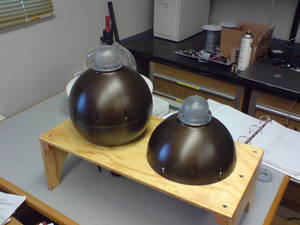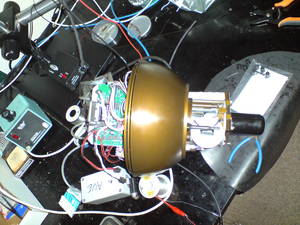Robots of the Ocean
Interview with
Jules - Over the past decade we've developed a rather large vehicle, something on the order of a Volkswagen Beetle-sized vehicle which has the capability of adjusting its buoyancy. On it we put laser and we put some very sensitive cameras. We put that off the ship. It weighs almost a tonne so it's hardly something you could go out on your row boat to put in the water! You need a fairly large ship. We've learned a lot of interesting things. The problem we kept coming up against (and it becomes more obvious) the more we process out data and the more we think about it is that we're just sampling one place at one time. Even though we get a nice picture from that place and there are inferences we can make; we're starting to work on distributed networks. Instead of having just one sampler in one place at one time we've got a small army of these things and they're all going up and down in the water. They're all sampling and they're all sampling different places at different times. If we know where they are and we know when they were there and we have the appropriate sensors on them we can start to reconstruct this three-dimensional distribution of these organisms and actually look at mechanism as opposed to just looking at, more or less, existence.
 Chris - How do you get them to talk to each other? A major problem with underwater communication: as submariners know very well you can't get radio signals through water very easily. How do you keep them in touch with each other?
Chris - How do you get them to talk to each other? A major problem with underwater communication: as submariners know very well you can't get radio signals through water very easily. How do you keep them in touch with each other?
Jules - The ocean, as you've already highlighted, is particularly opaque to electromagnetic radiation. Acoustics, on the other hand, as has been known by animals that have evolved over 100s of millions of years, can go very far. Our plan is to have these vehicles localising each other acoustically and we can communicate with one of them that is fairly close to us. They can distribute that message among the entire group by relaying that information. We think we can evolve sensor systems which can sense tens of kilometres instead tens of metres.
Chris - Would they be carried by ocean currents? You'd deploy a range of these things over a certain distance and the natural current would move them along?
Jules - Absolutely, we've actually had a wonderful insight into one of the advantages of our technology. We would like to be in the frame of reference of the organism itself. When you're sitting on a ship and you're bobbing up and down and you stick something in the water, that thing's going to be moving around. We found out a long time ago that it makes more sense to put the vehicle in the water and let it go with the flow, as we say, and to have maybe tens or even a hundred of these things. It allows us not only to take a snapshot of their evolving environment but also to track them. There are many enigmas in oceanography that we don't understand having to do with small animals that, say, are born onshore and have a pelagic part of their live where they go out to sea maybe for three months: a baby barnacle or something like that. Somehow they get back. To be honest, I don't have an idea how they do that. Most of the people I know who study these things don't have an idea how they do that! We can not only study this ten kilometre area but we can watch it evolve and be transported in time. Maybe start to unravel some of these riddles of how organisms survive in the ocean.
Chris - What you're building at the moment - is that going to be one of these vehicles?
Jules - That's correct. What we're looking at here, Chris, is something about the size of a soccer ball which has been cut in half. We're looking inside at the electronics of this device.
Chris - It looks like something that should be in Star Wars, actually...
Jules - There's a good story about that actually. In our last grant proposal to the national science foundation we wanted to put in a colour graphic of these devices. My colleague actually put the Death Star and shrunk it down. He created a picture where you have about 20 of these Death Stars communicating with each other. In fact we're not that far away.
 Chris - Is that the right message to be sending out because you're actually trying to save the Earth rather than destroy it!
Chris - Is that the right message to be sending out because you're actually trying to save the Earth rather than destroy it!
Jules - Yeah! Basically, we have this pretty simple thing. It's a soccer ball with a bunch of electronics inside it. The soccer ball's thick enough that we can send it down to about 80m of depth without imploding. The computer has sensors that tell it what the depth of the vehicle is. By adjusting its buoyancy (its volume in the ocean) we can actually send it down and keep it at a certain depth in the sea. What we also have on this vehicle: on the bottom here is an acoustic transmitter and receiver. We call that a transducer. It can send sound and receive sound. These are actually modems. They're actually communicating devices which allows these vehicles to talk to each other. They can actually range off each other. That allows us, knowing their depth and knowing how far they are from each other to estimate their 3D positions. Now imagine a fleet of maybe 100 of these things slowly descending in the sea, localising off each other; each equipped with some method of sensing plankton density or perhaps other things like zooplankton using acoustics. Using these hundred or so samples we can now create a 3D time-varying record of the evolution of a volume that might be 5km X 5km X 80m deep.
Chris - How long does it take you to develop something like this from concept to getting something that you can put into the pacific?
Jules - You've touched a very tender subject with me. You might have noticed I have a bit of comedy associated with my personality so what I tell my students is that if you're pregnant you're guaranteed within 9 months but if you're an engineer and you're building a vehicle it could be ten years. We're sort of giving birth. This has been an exciting week for us because ten years from the inception of this we've now started to test these things in the ocean on modem communication. It's really exciting but by the time - I tell our students that science is not something if you want immediate gratification - the time you think of the thing, write the proposal, perhaps get it rejected a few times before it's funded, do the research, get the results, process the data, publish it and go to colleagues and tell them what you've done it can often be a 7-10 year period.
- Previous Laser Eye Surgery
- Next The Origin of Life










Comments
Add a comment